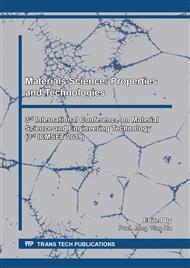p.1
p.5
p.9
p.15
p.21
p.27
p.33
p.39
Durability of Coatings Based on Sol Silicate Paint
Abstract:
The results of the study provide information on the resistance of coatings based on the solof silicate paint in the process of freezing and thawing. It was found, that coatings based on sol silicatepaints are characterized by a higher resistance compared of silicate coatings. It is shown, that thecoatings withstood 50 cycles of alternate freezing and thawing. The surface energy of the coatingswas calculated using the critical surface tension of the fluid at the interface with the solid. Thedispersion contribution in the intermolecular interaction between the particles of the coatings wasestimated. The values of the surface tension of the coatings and the values of the dispersioncomponent of the surface energy of the coatings — the complex Hamaker constant — are calculated.It was revealed, that after testing a decrease in the values of the Hamaker constant is observed. It wasestablished, that after testing for frost resistance, the values of the Hamaker constant for coatingsbased on sol of silicate paint are higher compared to coatings based on silicate paint.
Info:
Periodical:
Pages:
1-4
Citation:
Online since:
August 2019
Keywords:
Price:
Сopyright:
© 2019 Trans Tech Publications Ltd. All Rights Reserved
Share:
Citation:


